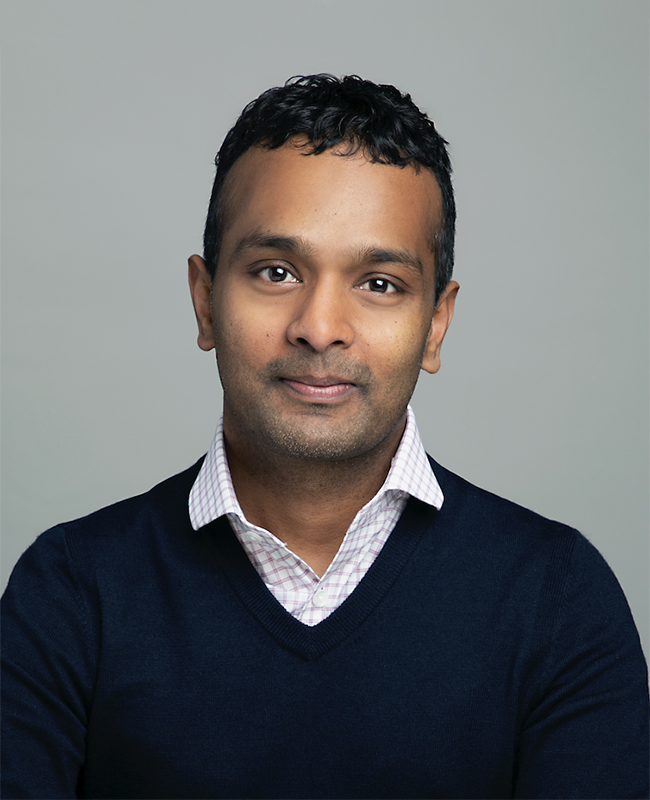Allen School professor Shyam Gollakota received the ACM Grace Murray Hopper Award from the Association for Computing Machinery for “contributions to the use of wireless signals in creating novel applications, including battery-free communications, health monitoring, gesture recognition, and bio-based wireless sensing.” Each year, the ACM Grace Murray Hopper Award honors an early-career professional in computing who has made a major technical or service contribution to the field before the age of 35.
As director of the Allen School’s Networks & Mobile Systems Lab, Gollakota advances big ideas in compact, energy-efficient form factors to expand the Internet of Things (IoT). Among his earliest contributions was ambient backscatter, a groundbreaking technique he pioneered with Allen School colleague and electrical engineering professor Joshua Smith. Backscatter essentially produces power out of thin air by harvesting television, WiFi, and other wireless signals to enable battery-free computation and communication. The team later refined and expanded their work to enable transmissions over greater distances and via embedded devices with long-range backscatter, and even produced a prototype of the world’s first battery-free cellphone. Gollakota also showed how backscatter communication could be accomplished without electronics with the introduction of 3D printed smart objects. The researchers started a venture-backed company, Jeeva Wireless, to commercialize their work.
Gollakota has also tapped into the sensing capabilities of smartphones to develop a series of health screening and monitoring tools in collaboration with clinicians at UW Medicine. These include a non-invasive app for detecting fluid in the ear — a symptom of ear infection and one of the most common reasons for visits to the pediatrician — and one for detecting obstructive sleep apnea that was subsequently commercialized by ResMed. He also showed how smartphones can be powerful tools for tackling broader public health crises with Second Chance, an app that employs sonar to monitor a person’s breathing and movements for signs of a potential opioid overdose. Gollakota and his colleagues have since explored how other smart devices, such as Amazon’s Alexa smart speaker, can be used for home health monitoring. To that end, he and his team have developed new smart speaker skills to detect if a person has an irregular heart rhythm or is experiencing a cardiac emergency and also to monitor a baby’s breathing during sleep. He co-founded two companies, Sound Life Sciences and Wavely Diagnostics, to commercialize this work.
A common thread running throughout Gollakota’s research is his creativity in addressing real-world problems while pushing the limits of what was previously thought possible through technology.
“Simply put, Shyam is amazing — he is easily the most creative person I have ever met,” said Allen School professor Thomas Anderson. “He repeatedly invents and builds prototypes that, before you see them demonstrated, you would have thought impossible. I do not know of any junior faculty member, in any area of computer science, whose work has had greater practical impact on our understanding of how to build useful systems.”
Lately, those systems have bridged the digital and natural worlds in Gollakota’s efforts to enable wireless sensing and computation to take off — literally as well as figuratively. In a series of projects that can be described as “living IoT,” Gollakota and his colleagues attached sensors to bees to demonstrate a system for wireless data transmission with applications in agriculture and environmental monitoring; outfitted a beetle with a steerable robotic camera that can be used to track moving objects and live-stream images to a smartphone; and developed a lightweight sensor that can be transported to hard-to-reach locations by moths in a step towards creating the Internet of Biological Things. Gollakota also has taken inspiration from nature to build insect-sized robots capable of wireless flight in a collaboration with mechanical engineering professor Sawyer Fuller.
“His work has revolutionized and re-imagined what can be done using wireless systems and has a feel of technologies depicted in science fiction novels,” the ACM said of Gollakota in a press release.
The ACM Grace Murray Hopper Award is accompanied by a monetary prize of $35,000, which Gollakota has opted to donate in support of LGBTQIA+ students in the Allen School.
“We are extremely proud of Shyam and his research group. They produce incredibly creative and innovative technology that also strives to address fundamental environmental and societal problems,” said Magdalena Balazinska, professor and director of the Allen School. “On a personal level, I am proud to call Shyam a colleague and am very happy to see him recognized with this award not only for his technical contributions, but also for his service as a mentor and role model for future innovators in our field.”
Gollakota is the second Allen School faculty member to receive the Grace Murray Hopper Award. The ACM previously recognized professor Jeffrey Heer in 2017 for his work on leading-edge visualization tools for exploring and understanding data.
Read the ACM announcement here, and learn more about the Grace Murray Hopper Award here. In addition, see our story on professor Anna Karlin receiving the ACM Paris Kanellakis Theory and Practice Award, also announced today, for her work on balanced allocation or the “power of two choices.”
Congratulations, Shyam!


